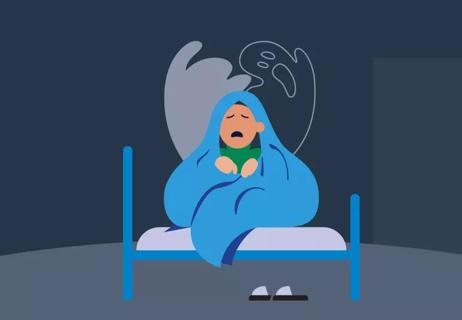Getting enough sleep and keeping the bedroom quiet and restful can help

You’re just starting to doze off when your child suddenly screams bloody murder. You race to their room in full rescue mode.
Advertisement
Cleveland Clinic is a non-profit academic medical center. Advertising on our site helps support our mission. We do not endorse non-Cleveland Clinic products or services. Policy
You get to their bedside to find your kid sitting straight up, inconsolable and seemingly immune to your comforting words.
What was that?
Chances are, you just encountered a night terror, also called a sleep terror.
“During a night terror, a child may scream, talk or cry but not really be awake,” explains pediatric sleep disorders expert Vaishal Shah, MD, MPH. “If the light is on, you can see they’re pale or sweaty. Their fight-or-flight response is fully activated.”
Different from waking from a nightmare, following a night terror, your child won’t remember a vivid dream that roused them or tell you about the monster they saw in the closet. To them, it’ll be as if the late-night panic never happened.
We talked with Dr. Shah about night terrors and ways to help your little one sleep soundly.
Without realizing it, we all wake up, look around, roll over and fall back to sleep throughout the night. That happens as we switch between stages of deep (non-REM) sleep and not-so-deep (REM) sleep. Typically, it happens two to six times per night.
Night terrors are sleep disturbances that happen as children (and sometimes adults) switch gears between deep sleep and lighter sleep phases. They usually occur in the first few hours after your child nods off.
Advertisement
“As we sleep, we alternate between REM sleep and non-REM sleep, spending 90 to 120 minutes in each cycle,” Dr. Shah explains. “But kids who have night terrors essentially ‘get stuck’ between waking up and being in the deepest stage of non-REM sleep.”
While distressing to parents and caregivers, night terrors aren’t a sign that your child is experiencing any underlying issues.
“Sleep terrors occur in normally developing children,” Dr. Shah says. “Parents often worry, but they’re not a sign of anxiety or any other psychological issues.”
Night terrors affect 2% to 7% of children and usually peak between ages 4 and 7. Most children outgrow sleep terrors before their teens.
When your kid wakes up from a nightmare, they’re probably going to seem scared and maybe crying. They may want to tell you about the bad dream.
If they’re having a night terror, though, your child won’t really be awake. They may try to talk or yell, but they probably won’t be forming full sentences or even words.
Other signs of a night terror include:
The next day, your child probably won’t remember the night terror episode. That’s because night terrors happen while your child is in the midst of a deep sleep.
Dr. Shah says sleep terrors may be over in a few seconds or may last several minutes. They may strike just a few times a year, semi-weekly or — in rare cases — several times a week.
Anything that keeps your kid from moving seamlessly from deep sleep to REM sleep can trigger a night terror.
“Being able to identify triggers can prevent or reduce the number of night terrors,” Dr. Shah says.
He explains how you can help your child sleep more soundly by addressing some of the most common reasons for night terrors.
Getting too little sleep one night makes your child sleep much deeper the next night, increasing the chance of an episode.
Learn how much sleep your kid needs for their age and strategies to help them get more shut-eye.
When your child isn’t feeling well, they may sleep more or sleep less restfully. That can affect their sleep patterns and lead to night terrors.
Help your little one stay healthy by practicing proper hand hygiene, avoiding people who are sick and getting a flu shot each year.
A noisy environment may lead to sleep disturbances as well.
Dr. Shah recommends keeping your kid’s room comfy for the ZZZs by keeping the lighting low and the temperature around 70 degrees Fahrenheit, or 21.11 degrees Celsius. If noises are inevitable, try a white noise or pink noise machine to block out some of the sounds.
Advertisement
Obstructive sleep apnea is a condition in which there are brief pauses in your child’s breathing pattern during sleep. It occurs in about 2% to 5% of kids, most commonly between the ages of 2 and 6. If your child can’t breathe correctly during sleep, it can trigger sleep terrors.
Signs your child may have sleep apnea include:
If your child shows signs of sleep apnea, talk with a healthcare provider about testing and treatment options.
Sleep disturbances can run in the family. Your child might be more prone to sleep terrors if one or both parents had them as well.
It’s best to allow a sleep terror to run its course. Trying to awaken your child in the midst of a sleep terror probably won’t work. If you do rouse your child, they’ll probably be confused or frightened to wake up so suddenly. Remember, they were sleeping during the night terror, so waking up to you in their room worrying about them will likely be concerning for them. That means more time and consoling to get back to sleep.
A better route, Dr. Shah advises, is to focus on keeping them safe by quietly and softly lying them back down if they’re sitting. If your child has frequent night terrors, you might consider adding a few extra pillows to their bed to protect them from bumping their head on a wall or headboard.
Advertisement
In rare cases, children who have frequent night terrors may benefit from medication, Dr. Shah adds.
Night terrors are really more alarming for parents than for their children. Find comfort in knowing your child will likely grow out of their night terrors soon. Talk with your healthcare provider if you’re concerned their night terrors are a result of sleep apnea or if they happen very frequently.
Advertisement
Learn more about our editorial process.
Advertisement

Nightmares in children are common and more likely when your child is overtired or stressed

Understanding one of sleep's big mysteries

The short answer from a sleep psychologist

A sleep expert weighs in

Type 2 diabetes isn’t inevitable with these dietary changes

Applying a hot or cold compress can help with pain